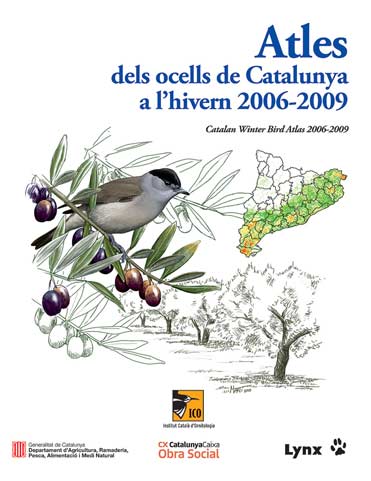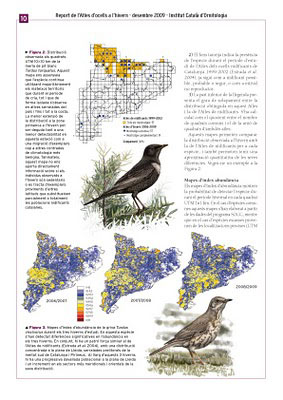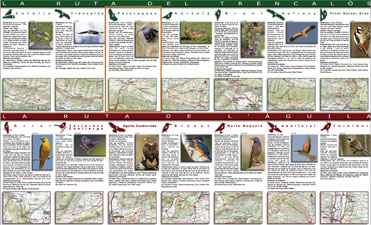Recently
we were asked to review the superb Catalan Winter Bird Atlas for the journal Ibis. Here is the review as it appears in the latest number of the “International Journal of Avian Science” Ibis (2012), 154, 414-434.

HERRANDO, S., BROTONS, L., ESTRADA, J., GUALLAR, S. & ANTON, M. (eds) Atles dels Ocells de Catalunya a l’Hivern 2006–2009 – Catalan Winter Bird Atlas 2006–2009. 649 pages, numerous colour maps, photographs, graphs, other illustrations (in colour and black and white), tabulated data in 3 appendices. Barcelona: Lynx Edicions in association with Institut Catala` d’Ornitologia, 2011. Website: http://www.lynxeds.com.
A first generation bird atlas: 1984 saw the publication of the first bird atlas for Catalonia, edited entirely in Catalan and titled Atles dels Ocells Nidificants de Catalunya i Andorra (reviewed in Ibis 128: 151–152). It used 10-km square grid maps to show the presence of breeding birds, with different-sized dots representing definite, probable or possible breeding.
The second generation: after many years of work in both field and office, the Catalan Breeding Bird Atlas 1999–2002 was published in 2004, 20 years after the first one. Its pages reflected the work of no fewer than 516 people, both volunteers and professionals, and represented a great evolutionary step in the organization of Catalan field ornithology. It was rightly acclaimed as a landmark publication for Catalan ornithology and was described by reviewer Paul Donald (in Ibis 147: 617– 618) as one of his ‘top ten’ bird atlases.
And now a third generation bird atlas? That’s what some are saying about the Catalan Winter Bird Atlas 2006–2009, including EBCC chairman R. P. B. Foppen in his Foreword, adding that it ‘creates a new standard in the world of bird atlases’. By building on the experiences of the 1999–2002 Atlas, which in turn set horizons far beyond the scope of the first – collating abundant data from diverse sources, and then applying an exhaustive, state-of-the-art analysis to produce detailed distribution maps showing relative abundance or probability of occurrence using density contour maps as the graphic base – the Catalan Ornithological Institute has been able to progress even further and, what’s more, the relatively short gap between publication of the breeding and wintering atlases adds substantially to the scientific and documentary value of both.

Surely one of the first thoughts that would strike anyone considering compiling a winter bird atlas is that it is no easy undertaking: harsh weather, often limited access to mountainous regions, the difficulty of representing changing distributions of bird species between and within winter periods, motivating and coordinating skilled field workers and volunteers, etc. That the Catalan Ornithological Institute has been able to do just that and more, with the participation of 885 people, the incorporation of diverse and sometimes dispersed data from atlas fieldwork, long-term monitoring schemes such as the Common Bird Census (SOCC), various ringing schemes, ornithological yearbooks, hunting statistics, waterbird censuses and so on, must be taken as some measure of the region’s keen ornithological aspirations.
Of the 318 bird species detected in the study period, 206 wintered regularly. By incorporating a wealth of maps, graphs, facts and figures, the book clearly illustrates the importance of the Mediterranean basin as one of the main wintering areas for many of the birds that breed in central and northern Europe. Its accurate, fine-grained distribution maps are viewer-friendly and easy to interpret. Plentiful graphs showing population trends, altitudinal and habitat preferences adorn the species accounts. For some species of an irruptive nature such as Goldcrest Regulus regulus, Hawfinch Coccothraustes coccothraustes or Yellowhammer Emberiza citrinella, there are even additional abundance maps comparing different years within the period. An attempt has also been made to ascertain the origin of some birds detected in the winter by using ringing recoveries wherever available.
English summaries in the species accounts are carefully drafted to ensure that the essential information on population estimates, distribution and temporal trends is included. In fact, this abridgement is virtually the only concession to layout and design in what is an essentially bilingual publication.
The atlas of winter birds boasts skillful bird illustrations of all the main species in winter habitats and plumages, an extensive section on habitats with photographs and full descriptions of each, and introductory sections on winter weather, the methodology of data gathering and analysis, as well as additional species accounts for exotic or introduced species, and condensed versions for regular and irregular very rare species.

This is a robust book, both in appearance and content, and in my opinion to place this alongside its breeding birds equivalent as one of the top 10 bird atlases would be too conservative an appraisal. More than just another bright feather in the cap of the Catalan Ornithological Institute, it is a monument to Catalan ornithology and citizen science, and is capable of standing up to any challenge put to bird atlases around the world up until the present day. Any organization contemplating the elaboration of its own country’s or region’s bird atlas should regard it as an essential early reference. Beyond that, it is a delight to possess in itself, but not a book to be lent to one’s friends without first demanding a receipt.
ª 2012 The Authors
Ibis ª 2012 British Ornithologists’ Union





